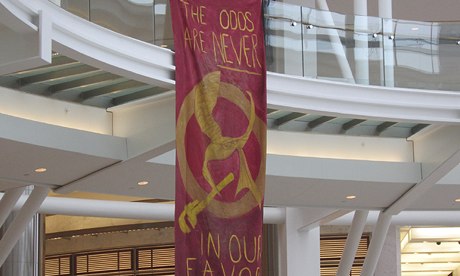by Suzanne Goldenberg, US environment correspondent, The Guardian, January 11, 2014

Two environmental protesters are under investigation on terror charges in Oklahoma after unfurling this Hunger Games tribute banner in the lobby of the offices housing oil and gas company Devon Energy on 13 December 2013. Photograph: gptarsandsresistance.org
The terror charges facing two environmental protesters who unfurled a banner and dropped glitter at an oil and gas company's office in Oklahoma are "outrageous" and "egregious," according to the lawyer representing them.
The authorities have already collected about 100 reports, including witness statements, surveillance video and other evidence to support the charges of terrorism hoax against the two protesters, Oklahoma city police told the Guardian.
The charge, which carries a maximum penalty of 10 years, has yet to be confirmed by the Oklahoma city district attorney. If the charges do go ahead, it would be the first such use of Oklahoma's "terrorism hoax" statute in recent memory.
But the application of anti-terror statutes to a peaceful protest by barely a dozen activists has already caused outrage. Police concede there were no injuries in the protest.
"I have seen some pretty egregious stuff in my day, but these kind of charges are just outrageous and they are certainly the most egregious that I have seen," said Douglas Parr, lawyer for the two activists. "There is just no way the facts justify filing those charges."
Moriah Stephenson, 27, a waitress and graduate student, and Stefan Warner, 26, a youth pastor turned full-time organiser for the Great Plains Tar Sands Resistance, were part of a small group of about a dozen activists at the glass office tower housing Devon Energy on 13 December.
Devon, which is based in Oklahoma, is a leading player in oil and natural gas drilling and also has interests in Alberta's tar sands and the Keystone XL pipeline.
As the protest got under way, Stephenson and Warner broke off from the group, and made their way to the second floor overlooking the large public atrium.
They had no intention of getting arrested, Stephenson said. She had to study for finals. "Our plan was to do something safe," she said.
They quickly unfurled their banner, a red sheet with a gold mockingjay symbol and the words "The odds are never in our favor" – references from the Hunger Games books and films.
But to the protesters' dismay the glitter came unstuck, and began drifting towards the floor.
After a few uneventful minutes, Stephenson and Warner took down the banner and left the building – apologising to the janitor who came hurrying over with a broom.
A few people, clutching coffee cups, wandered around in the lobby below, according to Stephenson. But she did not detect much of a response to the banner. There wasn't even that much mess, she said. The pair had used just four small tubes of glitter on their two banners.
"A lot of people when they heard about it they imagined buckets of glitter being dumped on people running and screaming, and chaos and panic," Stephenson said. "It wasn't chaos and panic at all. It was a pretty boring protest until the police showed up and decided to make a big deal of everything."
But that was not how it was seen by either Devon Energy or the Oklahoma city police. According to the arrest report, a Devon security representative notified police of the protest and "an unknown black powdery substance".
"They seemed to be staging some type of protest," the report said. "There was fear the substance spilled out could have possibly been a hazardous material."
Captain Dexter Nelson, an Oklahoma city police spokesman, went even further, saying the glitter had set off a panic.
He said residents still carried the psychological scars of the 1995 Oklahoma city bombing, when 169 people were killed and hundreds more injured.
"From the totality of the incident when they unveiled the banners and this black powder went flying through the air, all of the people who saw it deemed that it had to be something dangerous or toxic and went into a panic," Nelson said. "From what I was told people were running around and thinking that it was something dangerous."
Nelson also said the protesters were covered in faeces – a claim the protesters and Parr denied.
"At least one of the individuals had faeces on their clothing and they were dressed alike," Nelson said. "They looked like homeless people. They looked like some of our regular downtown transient."
He went on: "There was at least one individual that I saw she had it on her pants and her shoes," he said.
Parr, who was at the tower that morning, was outraged. "Any comment that either one of those people was covered in faeces is an absolute, unmitigated lie," he said.
In addition to terrorism hoax, Stephenson was charged with disorderly conduct, causing panic, and trespass. Warner was also charged with trespassing and disorderly conduct.
Two other protesters who had locked themselves to the doors of the building were also arrested. Cory Matthis and Caroline McNally face trespassing charges.
The final decision on a "terrorism hoax" prosecution now rests with the Oklahoma city district attorney, David Prater. He said he was still awaiting the full police report.
For Stephenson and Warner, however, the episode was evidence of a pro-industry bias in the heart of America's oil and natural gas boom.
"It sends a message to other activists that the price of dissent is very high," said Stephenson.
Warner said: "It's just a reminder of the consolidation of power between the state and private industry."
Prater rejected both arguments. "The information that some company or coalition of companies has trained law enforcement or in some way convinced law enforcement to use terror statues to go after peaceful protesters that is just not factual," he said. "That is not true in our jurisdiction. We are not under any influence at all from anyone."







No comments:
Post a Comment